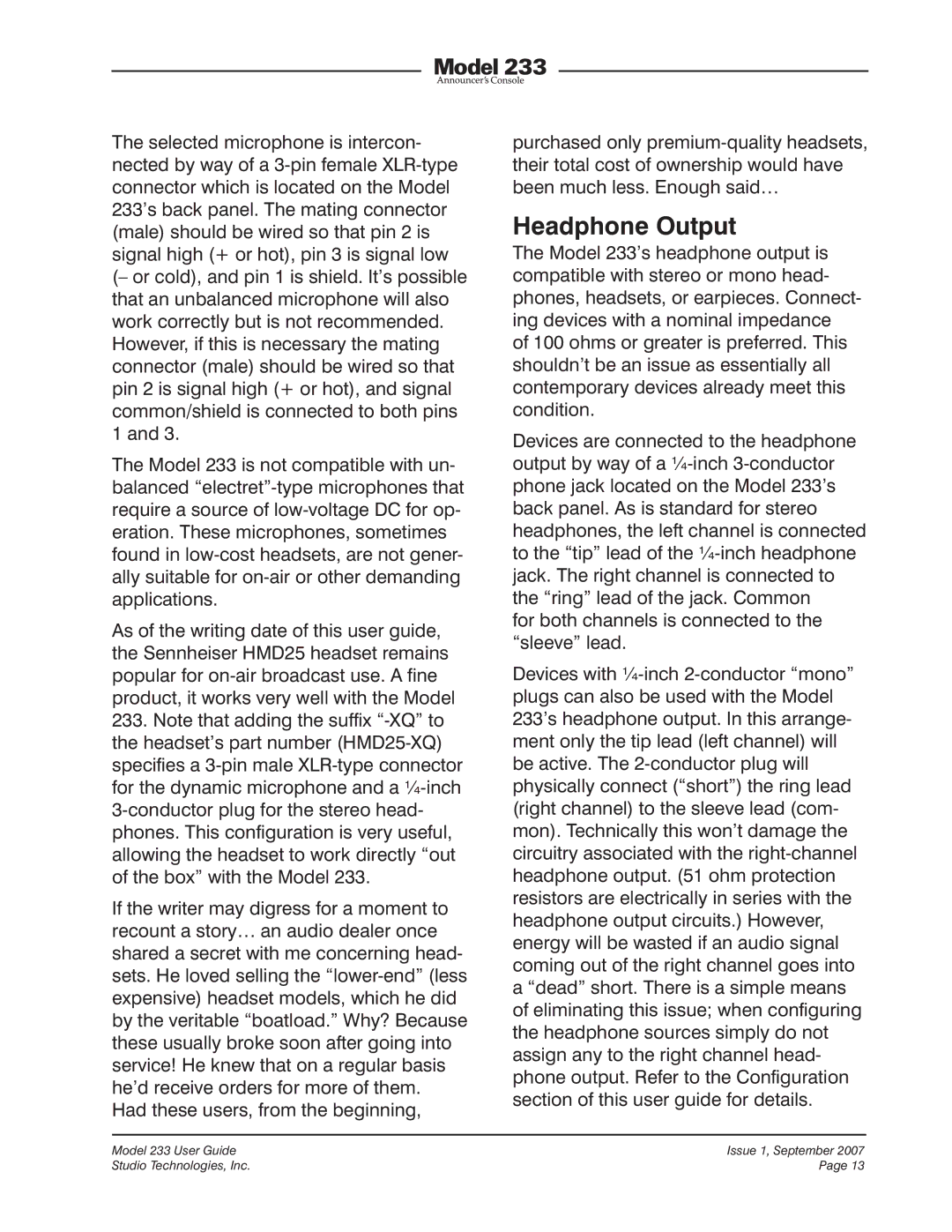The selected microphone is intercon- nected by way of a 3-pin female XLR-type connector which is located on the Model 233’s back panel. The mating connector (male) should be wired so that pin 2 is signal high (+ or hot), pin 3 is signal low (– or cold), and pin 1 is shield. It’s possible that an unbalanced microphone will also work correctly but is not recommended. However, if this is necessary the mating connector (male) should be wired so that pin 2 is signal high (+ or hot), and signal common/shield is connected to both pins 1 and 3.
The Model 233 is not compatible with un- balanced “electret”-type microphones that require a source of low-voltage DC for op- eration. These microphones, sometimes found in low-cost headsets, are not gener- ally suitable for on-air or other demanding applications.
As of the writing date of this user guide, the Sennheiser HMD25 headset remains popular for on-air broadcast use. A fine product, it works very well with the Model
233.Note that adding the suffix “-XQ” to the headset’s part number (HMD25-XQ) specifies a 3-pin male XLR-type connector for the dynamic microphone and a ¼-inch 3-conductor plug for the stereo head- phones. This configuration is very useful, allowing the headset to work directly “out of the box” with the Model 233.
If the writer may digress for a moment to recount a story… an audio dealer once shared a secret with me concerning head- sets. He loved selling the “lower-end” (less expensive) headset models, which he did by the veritable “boatload.” Why? Because these usually broke soon after going into service! He knew that on a regular basis he’d receive orders for more of them.
Had these users, from the beginning,
purchased only premium-quality headsets, their total cost of ownership would have been much less. Enough said…
Headphone Output
The Model 233’s headphone output is compatible with stereo or mono head- phones, headsets, or earpieces. Connect- ing devices with a nominal impedance of 100 ohms or greater is preferred. This shouldn’t be an issue as essentially all contemporary devices already meet this condition.
Devices are connected to the headphone output by way of a ¼-inch 3-conductor phone jack located on the Model 233’s back panel. As is standard for stereo headphones, the left channel is connected to the “tip” lead of the ¼-inch headphone jack. The right channel is connected to the “ring” lead of the jack. Common
for both channels is connected to the “sleeve” lead.
Devices with ¼-inch 2-conductor “mono” plugs can also be used with the Model 233’s headphone output. In this arrange- ment only the tip lead (left channel) will be active. The 2-conductor plug will physically connect (“short”) the ring lead (right channel) to the sleeve lead (com- mon). Technically this won’t damage the circuitry associated with the right-channel headphone output. (51 ohm protection resistors are electrically in series with the headphone output circuits.) However, energy will be wasted if an audio signal coming out of the right channel goes into a “dead” short. There is a simple means of eliminating this issue; when configuring the headphone sources simply do not assign any to the right channel head- phone output. Refer to the Configuration section of this user guide for details.

